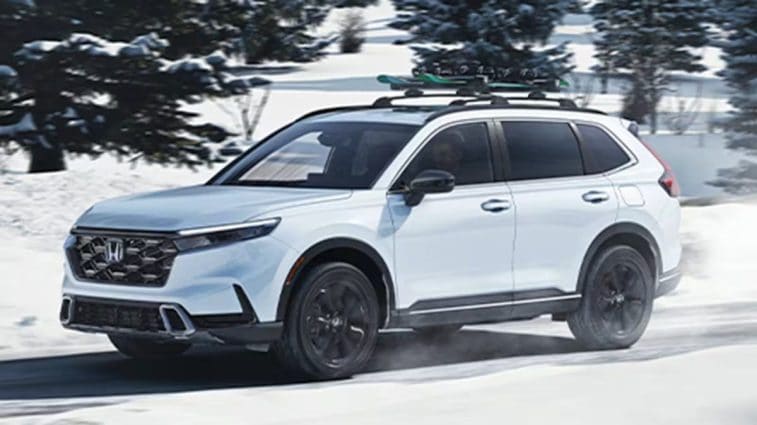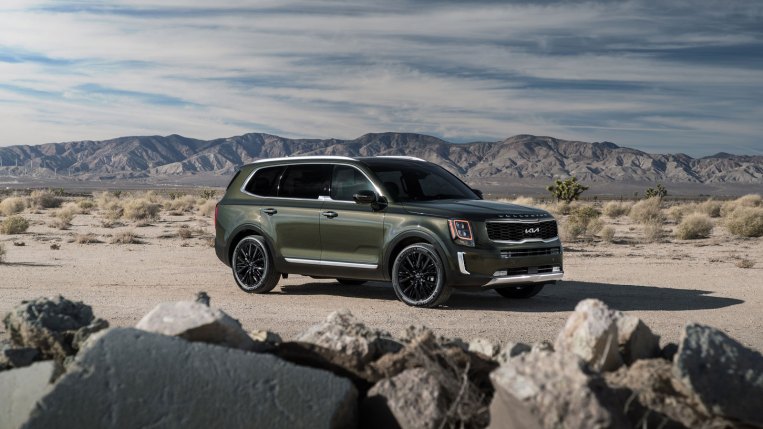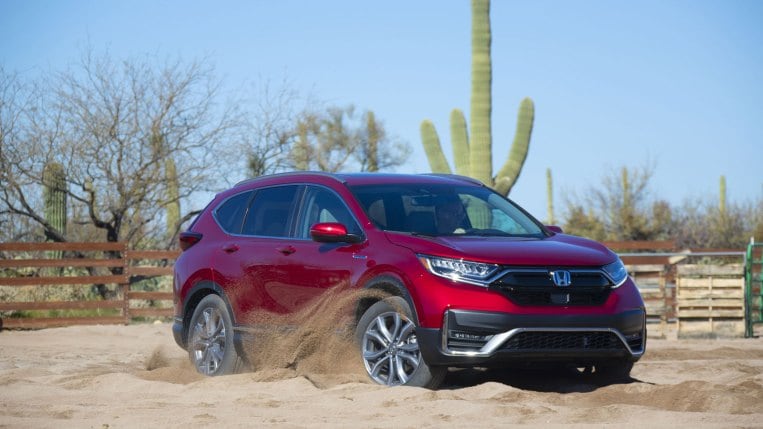Quick Facts About AWD and 4WD
- All-wheel drive (AWD) costs more than front-wheel drive but provides added traction in bad weather.
- 4-wheel drive (4WD) allows more towing capability than all-wheel drive.
- It’s not wise to use 4-wheel drive on anything but slippery, loose, or rugged surfaces.
- All-wheel drive is the way to go If you need a bit of extra peace of mind when driving in foul weather conditions such as ice, snow, sleet, and rain.
You probably have a good reason to consider a car, truck, or SUV with 4-wheel drive or all-wheel drive. Maybe it’s as simple as improving mobility in snow, gravel, and mud. Or, you might have dreams of rock crawling in Moab, Utah, or taking the family camping at a hard-to-reach spot by the lake.
Do you plan on towing anything? Which is better?
Although sometimes the terms all-wheel drive (AWD) and 4-wheel drive (4WD) are used interchangeably, they are not the same. In fact, they have very little in common. To some extent, some automakers muddy the water even further by marketing various all-wheel-drive and 4-wheel-drive systems with obscure names. For example, Mercedes-Benz uses 4MATIC, while BMW lays claim to xDrive for its all-wheel-drive systems.
Focusing on exactly what you want to accomplish with all four wheels under power will pinpoint which system works best for you when buying a car.
- All-Wheel Drive Defined
- 4-Wheel Drive Defined
- What Is the Difference Between AWD and 4WD?
- How All-Wheel Drive Works
- How 4-Wheel Drive Works
- AWD vs. 4WD With Ice, Snow, and Rain
- What Is 2-Wheel Drive?
- Car vs. SUV vs. Truck: Which Is Better for AWD or 4WD?
- Conclusion
All-Wheel Drive Defined

All-wheel drive is a system primarily engineered for on-road use. In its purest form, it sends engine torque to all four wheels simultaneously. However, it isn’t a one-size-fits-all system. There are actually two types of all-wheel drive.
Full-time AWD
Full-time all-wheel drive sends some amount of engine torque to both axles all the time. The system monitors wheel grip and determines just how much power goes to each set of wheels. When the rear wheels begin to lose grip, the system sends more torque to the front wheels. If the front wheels lose grip, the rear wheels get more power. Under normal conditions, both sets of wheels receive some percentage of torque. Subaru’s Symmetrical All-Wheel Drive you find on the Outback, Forester, and other models, is a full-time all-wheel-drive system.
Part-time AWD
Part-Time AWD sends all the engine torque to the front wheels during normal driving conditions, diverting some percentage of torque to the rear wheels when the drive wheels lose traction. That is, under normal driving conditions, vehicles with part-time all-wheel drive operate as front-wheel drive. When the system senses some slippage in the primary drive wheels, it transfers some amount of engine power to the other axle. For example, the Ford Escape’s system is part-time all-wheel drive.
The key for both all-wheel-drive systems is that all of this transferring of engine torque from axle to axle works transparently. The driver doesn’t take any action. It’s all automatic. True, some systems allow the driver to engage a driving mode for more extreme conditions. For instance, Subaru’s X-Mode, standard on all the Outback trims and all but the base trim on the Forester, is such a feature. X-Mode tweaks the powertrain response and other functions to ultimately enhance traction. Generally, however, the driver doesn’t need to take any action for the all-wheel drive to function.
RELATED: Best Cars and SUVs for Snow: Features You Need
4-Wheel Drive Defined
Whether you call it four-wheel drive, 4-wheel drive, 4WD, or 4×4, it is typically a part-time system engineered more for off-road driving than roads affected by foul weather. In most cases, the driver must shift in and out of 4-wheel drive.
Some systems are more complex and capable than others. But when the driver shifts into 4-wheel drive, it locks the front and rear axles together, meaning all four wheels receive equal power and rotate at the same speed. Once engaged, these systems don’t rely on a computer to sense wheel slip.
All wheels have power. If one or two wheels lose grip, the other wheels propel the vehicle forward. You will find 4-wheel-drive systems in vehicles like the Jeep Wrangler, Ford Bronco, Toyota 4Runner, and Chevrolet Colorado, not to mention almost every other pickup truck.
What Is the Difference Between AWD and 4WD?
All-wheel drive is a computer-supervised full-time system, operating as 2-wheel-drive most of the time. It automatically switches to all-wheel drive when necessary. 4-wheel drive is a more capable part-time system engaged by the driver when needed. All-wheel drive is more for foul weather, while 4-wheel drive is engineered for extreme conditions and off-roading.
Which Is Better, 4WD or AWD?
Depending on what you need the system to do, either can be better. All-wheel drive requires no driver input and is best suited to slippery roads. Four-wheel drive is usually a part-time system requiring the driver to engage and disengage it. It’s engineered more for navigating tricky terrain.
How All-Wheel Drive Works

What many all-wheel-drive systems have in common is a center differential located between the front and rear axles. A computer and sensors monitor the primary drive wheels for wheel slippage. When slippage occurs, the system transfers engine power to the other axle via the center differential.
Other all-wheel-drive systems for gas-powered vehicles may employ more than one differential, multi-plate clutches, or viscous couplings to help swap power from axle to axle.
Typically, the power split is up to 50%. Some systems, however, can shift as much as 100% of power back and forth between axles. The Acura Super-Handling All-Wheel Drive (SH-AWD) system does this; however, the more sophisticated all-wheel-drive systems, like Acura’s, also have torque vectoring. This is a big help in cornering on dry pavement because a torque vectoring differential on each axle slows the rotation of the inner wheel while accelerating the rotation of the outer wheel in a turn.
Regarding slick surfaces, torque vectoring can shuffle as much as 100% of an axle’s power back and forth to one solitary wheel, if necessary. The brake lock differential on the Jeep Grand Cherokee QuadraTrac full-time all-wheel-drive system employs anti-lock brakes to mimic torque vectoring.
AWD for Electric Vehicles
Electric powertrains have a different setup. A typical electric vehicle (EV) has one motor that drives either the front wheels or the rear wheels. To achieve all-wheel-drive functionality, the EV needs a second motor that operates the second axle. The dual-motor Tesla Model Y, Kia EV6, and Ford F-150 Lightning are some common EVs with the one-motor-per-axle configuration required for EV all-wheel-drive capability. Some EVs go with a tri-motor (usually two in the rear) or quad-motor setup, with a motor for every wheel, but are relatively novel and expensive.
AWD Pros
There are advantages to all-wheel-drive systems.
- Added traction in bad weather
- Operates automatically and seamlessly
- System reaction is quicker than human response
- More fuel-efficient than 4-wheel drive
- Added value if you sell
AWD Cons
All-wheel-drive systems also have drawbacks.
- Cost
- Not engineered for more extreme situations
How 4-Wheel Drive Works
Not always, but most commonly, 4-wheel drive is a part-time system. As we’ve already pointed out, various automakers take different paths to power all four wheels. But to keep things simple, most 4-wheel-drive systems work part-time.
Unlike all-wheel-drive systems, which rely on a computer to shift engine output to all four wheels, 4-wheel-drive systems require some driver participation to get the most performance out of all wheels. This means the driver must engage the system at some point by way of a button, dial, or shift lever. A true 4-wheel-drive system should never be engaged on dry pavement.
It’s not wise to use it on anything but slippery, loose, or rugged surfaces because both axles lock together, with all four wheels rotating at exactly the same speed. This isn’t much of an issue when traveling in a straight line on dry pavement. However, in turning the vehicle, the outside wheels must turn faster than the inside wheels.
This creates a situation where, when 4-wheel drive is engaged, the wheels on one side of the vehicle fight the wheels on the other side. This puts a lot of stress on the system and is a sure way to cause damage. On slippery or loose (gravel) surfaces, though, all four wheels are free to slide and travel their separate arcs through a curve without stress.
Gear Settings for a 4WD Vehicle
- 2-wheel drive (2WD) or 2-Hi is the normal mode for dry pavement. In 2-Hi, a vehicle functions as a rear-wheel-drive (RWD) vehicle.
- 4-Hi brings all four wheels to bear, locking the axles together with a fairly even split of engine power to each.
- 4-Lo or 4-Low usually requires the driver to bring the vehicle to a full stop to transition from 4-Hi. This is the gear for extreme conditions, generating more torque for difficult, low-speed situations.
There are some higher-end 4-wheel-drive systems with an automatic setting for 4-Hi. The system is engineered to allow the outside and inside wheels to rotate at different speeds when in 4-Hi. These systems then function like an all-wheel-drive system most of the time.
When conditions become too extreme for 4-Hi, the driver must take charge and manually shift into 4-Lo.
4WD Pros
4-wheel-drive systems have benefits.
- Off-roading capability
- More towing capability than AWD
- Extra weight of 4WD contributes to improved traction
4WD Cons
4-wheel-drive systems also have disadvantages.
- Poor fuel economy
- Can’t safely operate on dry pavement
- Additional weight increases stopping distances
AWD vs. 4WD With Ice, Snow, and Rain
In a nutshell, if all you are looking for is a bit of extra peace of mind when driving in foul weather conditions such as ice, snow, sleet, and rain, AWD is the way to go. AWD removes some of the drama from snow and ice driving.
If you deal with extreme snow and ice, 4-wheel drive is the ticket.
If you also want to off-road into the wild, 4-wheel drive works better when you want to wander off the pavement. Moreover, 4-wheel-drive vehicles tend to offer far more towing capacity than all-wheel-drive vehicles; however, all the extra capability comes at a price. While 4-wheel drive’s extra weight improves traction, it is a big disadvantage at the gas pump.
All-wheel drive boasts the advantage of being a seamless system. Power goes to all four wheels when the system senses it’s needed and back to two wheels when it isn’t. Many all-wheel-drive systems add very little weight to the vehicle and, therefore, have little impact on fuel economy.
What Is 2-Wheel Drive?
Most vehicles generate their propulsion using either the front or rear wheels. Even most all-wheel-drive and 4-wheel-drive vehicles act like 2-wheel drive vehicles when conditions allow. Cars with only two drive wheels have the advantage of being lighter and burning less fuel than those with all-wheel or 4-wheel drive.
What Is Rear-Wheel Drive?
Rear-wheel drive was the primary propulsion setup for cars into the early 1980s before front-wheel drive began making serious inroads. Rear-wheel drive uses a driveshaft connected to the transmission to transfer engine output to a car’s rear axle. There, a differential reroutes the output along the axle to both rear wheels. Because each set of wheels has its own task (front steering and rear powering), rear-wheel drive tends to provide better cornering than front-wheel drive.
Front-wheel drive cars tend to be lighter than rear-wheel-drive cars because they don’t require all the hardware needed to distribute power to the rear wheels. Front-engine front-wheel-drive vehicles are better suited for foul weather because most of their weight is over the drive wheels.
What Is the Difference Between 2WD and 4WD?
With 2-wheel drive, propulsion is derived exclusively from either the front or the rear wheels. A 4-wheel-drive system’s default is rear-wheel drive. On slippery, loose, or uneven surfaces, the driver must engage 4-wheel drive to lock together both sets of wheels. Receiving equal amounts of engine power, all four wheels move the vehicle forward.
Car vs. SUV vs. Truck: Which Is Better for AWD or 4WD?

Here’s the thing: Most pickup trucks only use 4-wheel drive versus all-wheel drive. Exceptions to this are the Honda Ridgeline, Ford Maverick, and the Hyundai Santa Cruz because they offer all-wheel drive. It is also exclusive to cars and minivans. Only SUVs/crossovers accommodate both. So, it’s not so much about which platform works best for which system, but which type of vehicle you want or need.
If your answer to that is a pickup truck, you have little choice other than 4-wheel drive. Likewise, if a minivan or car is your vehicle of choice, it’s all-wheel drive.
RELATED: Driving in Snow: Top Tips You Need
Truck-based SUVs typically use a 4-wheel-drive system to power all four wheels. Car-based crossovers use all-wheel drive. Truck-based SUVs typically offer more ground clearance, which is good for getting over obstacles and snow. They also boast more towing capability.
Although some crossovers, like the Subaru Outback, tout impressive ground clearance (8.7 inches), they generally have less ground clearance than a truck-based SUV and are poorly suited for straying very far off the pavement.
Conclusion
Comparing all-wheel drive to 4-wheel drive is an apples-to-oranges discussion. Although they both involve schemes for motivating all four wheels, each system possesses a unique skill set. Whereas all-wheel drive is primarily a foul-weather system requiring virtually no driver involvement, 4-wheel drive is tougher and more formidable. Offering ascending degrees of capability, it’s the driver and not a computer that usually controls the system’s engagement and degree of capability. If you want better traction on surfaces made slippery by rain, snow, gravel, and mud, while minimizing the amount of fuel consumed, all-wheel drive is the answer. On the other hand, hardcore off-roading, heavy-duty towing, and other more intense driving situations demand the extra control and ruggedness of 4-wheel drive.
In other words, the best answer to the right combination of vehicle type and four-wheel configuration is the one that suits your needs.
RELATED: Car Tires Guide: Everything You Need to Know
Editor’s Note: This article has been updated since its initial publication.

